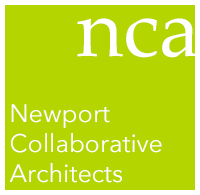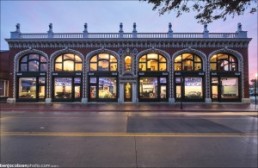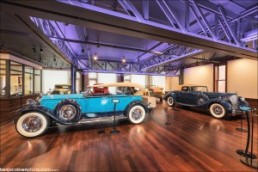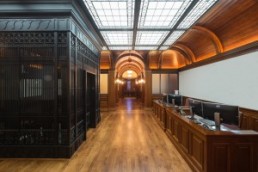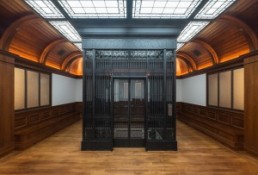Audrain Building Earns 2014 AIA RI Honor Award in the Commercial Category
Audrain Auto Museum Earns 2014 AIA RI Honor Award in the Institutional Category
Noted architect Bruce Price designed the Audrain Building that was constructed in Newport, Rhode Island in 1903. The 16,000 square foot commercial building represents one of four Gilded Age buildings that form an architecturally significant block on Bellevue Avenue. The three adjoining historic buildings include the Travers Block designed by Richard Morris Hunt; the Newport Casino designed by McKim, Mead, and White; and the King Block designed by Perkins and Betton.
Price drew inspiration from the Florentine Renaissance to create an iconic two-story edifice defined by broad arched windows that rise through both stories and a roofline distinguished by white terra-cotta balustrade with lion sculptures. The Audrain Building is faced in red brick with jewel toned terra cotta trim that accentuates the entry, bays and roofline. Street-level terra-cotta ornamentation is relatively restrained but increases at the arched second floor windows and cornice. The first floor was originally designed to feature six retail shops and the second floor accommodated 11 offices.
During the 20th century, a hurricane damaged the balustrade and the lion sculptures warranting their removal. Over time, the first floor retail shops transitioned into medical offices while the second floor housed many commercial tenants who made few improvements to the lackluster offices.
In November 2013, the client purchased the Audrain Building and enlisted NCA to transform the second story offices into the summer headquarters for his Fortune 500 Company. The project was completed in nine short months. In February 2014, the client also enlisted NCA to transform the first floor into a museum that would showcase his collection of antique automobiles. Completed in six months, the museum project was on a parallel track to designing his summer headquarters on the second floor.
In addition to the fast track schedule, the small site posed limitations. The building is part of a commercial block with limited service access on both the north and east sides. Staging for the construction and lifting of equipment on the roof was problematic due to the high volume of pedestrian and vehicular traffic during the busy summer months.
To replicate and replace missing terra-cotta ornamentation, rooftop balustrade and lion sculptures the architect relied on historic photographs and postcards. Structural engineering was required to bring the building up to code to accept the additional weight of the new ornamentation. All of the windows were replaced with impact resistant glass. The South elevation was originally hidden by the neighboring Ocean House Hotel. The hotel was destroyed by fire in the 19th century, which caused the unadorned South elevation to be exposed. The design team upgraded the sparse elevation with a large two story arched opening, three double-hung windows, and a new fire stair with a powder coated steel balustrade. The local Historic District required that the new South façade details be discernible to the observer by the simplification of replicated detail.
For the office interiors, the client wished to emulate an early 20th century club. The bold concept called for reconfiguring the layout to accommodate a new carrera marble lobby, custom steel caged elevator, barrel vaulted ceiling, six private offices, support-staff area, conference room, kitchen, restrooms and a 20’x20’ leaded glass skylight. The fixture incorporates LED technology with filters to mimic the look of natural daylight streaming through a traditional skylight.
The museum project entailed removing all of the existing bearing walls, shoring the structure, reinforcing the floor to accommodate triple load bearing tongue and groove Douglas fir decking, and installing powder coated steel, fire-rated trusses. All of the windows were replaced with impact resistant glass. The South elevation was upgraded with a large two story arched opening that was custom fit to allow antique cars to access the building. The museum’s interiors feature state-of-the-art LED/RGB lighting for the structural steel trusses and track LED lighting for the cars. The program also called for public restrooms. The architect used stainless steel to create custom dividers and counters.
